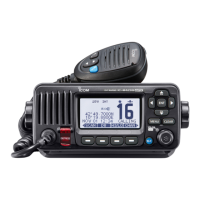
Do you have a question about the Icom ic-m423g and is the answer not in the manual?
| Brand | Icom |
|---|---|
| Model | ic-m423g |
| Category | Transceiver |
| Language | English |
Lists key features of the VHF marine transceiver, including DSC and GPS capabilities.
Advises reading all instructions and saving the manual for future reference.
Defines terms like WARNING, CAUTION, and NOTE to indicate potential risks.
Step-by-step guide for making a distress call using Channel 16.
Steps for initiating a distress call using Digital Selective Calling on Channel 70.
A list of country codes as defined by ISO 3166-1.
Explains RF exposure limits, MPE radius, and safe installation distances.
FCC statement regarding compliance for Class A unintentional radiators.
Note regarding the placement of the FCC warning sticker.
Covers electrical safety, placement, environmental limits, and cleaning.
Guidelines on call priority, information privacy, and channel monitoring.
Details requirements for obtaining and maintaining radio station and operator licenses.
Describes the front panel controls, function display, indicators, and softkey functions.
Details the controls and functions of the supplied speaker microphone.
Step-by-step guide for entering the Maritime Mobile Service Identity (MMSI) code.
Procedure for entering the ATIS code for specific regional versions.
How to select and use regular, weather, and call channels.
Procedures for receiving audio and transmitting voice communications.
Guide to setting the audio volume and squelch levels for clear reception.
How to use the microphone lock and adjust screen backlight.
Instructions for using the AquaQuake feature to clear water from the speaker grill.
Explanation of Priority and Normal scanning modes.
How to add or remove channels from the scan list.
Procedures for starting, resuming, and stopping scan operations.
Explanation of how Dualwatch and Tri-watch monitor channels.
Steps to activate and use the Dualwatch and Tri-watch monitoring features.
Entering, editing, and deleting individual and group DSC IDs.
Manual input of ship's position and UTC time for DSC calls.
Detailed procedure for transmitting a DSC distress alert.
Procedures for individual, group, all ships, position, polling, and test calls.
Handling incoming distress, individual, group, and position calls.
Customizing auto-acknowledgement, channel switching, alarms, and squelch.
How to use the intercom function with the COMMANDMIC accessory.
Instructions for operating the Public Address system and sounding the horn.
Guide to accessing and operating the transceiver's menu interface.
Lists available menu sections: DSC Calls, DSC Settings, Radio Settings, Configuration, MMSI/GPS.
Configuring scan types, resume timers, channel groups, and weather alerts.
Adjusting backlight, contrast, key beep, key assignment, UTC offset, noise cancel, inactivity timers.
Configuring NMEA data output and setting the Remote ID number.
Diagrams and descriptions for connecting antennas, GPS, speakers, and power.
Steps for connecting the MA-500TR AIS transponder for DSC calls.
Covers fuse replacement, cleaning, and antenna considerations.
Instructions for mounting the transceiver and installing the microphone.
Detailed electrical, performance, and physical specifications of the transceiver.
List and description of optional accessories like flush mount kits and microphones.
List of VHF marine channels, frequencies, and usage notes for different regions.
Table of common issues, their possible causes, and recommended solutions.
A printable template for cutting holes for flush mounting accessories.